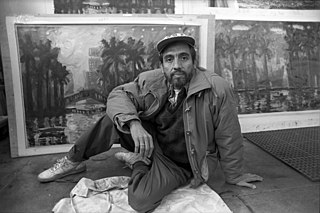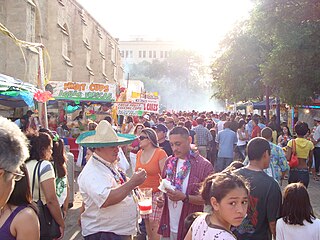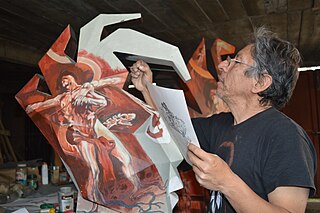
La Calavera Catrina had its origin as a zinc etching created by the Mexican printmaker and lithographer José Guadalupe Posada (1852–1913). The image is usually dated c. 1910-12. Its first certain publication date is 1913, when it appeared in a satiric broadside as a photo-relief etching.

Carlos D. Almaraz was a Mexican-American artist and a pioneer of the Chicano art movement. He was one of the founder of the Centro de Arte Público (1977–1979), a Chicano/Chicana arts organization in Highland Park, Los Angeles.

Gronk, born Glugio Nicandro, is a Chicano painter, printmaker, and performance artist. His work is collected by museums around the country including the Smithsonian American Art Museum.

The Centro Cultural de la Raza is a non-profit organization with the specific mission to create, preserve, promote and educate about Chicano, Mexicano, Native American and Latino art and culture. It is located in Balboa Park in San Diego, California.The cultural center supports and encourages the creative expression “of the indigenous cultures of the Americas.” It is currently a member of the American Alliance of Museums.
Kathy Vargas is an American artist who creates photographs from multiple exposures that she hand colors. She often devotes several works to a particular theme, creating series.

Fiesta San Antonio is an annual festival held in April in San Antonio, Texas, and is the city's signature event since 1891. The festival, also known as the Battle of Flowers, commemorates of the Battle of the Alamo, which took place in San Antonio, and the Battle of San Jacinto, which led to Texas' independence from Mexico in April 1836.
César Augusto Martínez is an artist, prominent in the field of Chicano art. While studying at what was then called Texas A&I College, he became involved in the Chicano movement for civil rights. He subsequently befriended several of its leaders.
The Museo Alameda was the largest Latino museum in the United States and the first formal Smithsonian affiliate outside of Washington D.C., located in the historic Market Square in Downtown San Antonio, Texas.

Jason Villegas is currently a San Francisco based contemporary artist. He has exhibited across the United States and internationally. Villegas' work utilizes a wide spectrum of mediums including sculpture, installation, painting, drawing, textile, video and performance. He has created his own artistic realm and visual language in which to explore concepts such as globalism, evolution, sexuality, cosmology, and consumerism. Motifs in Villegas' artworks include fashion logos, animal hybrids, weaponry, sales banners, clothing piles, anuses, cosmic debris, taxidermy, bear men, amorphous beasts, religious iconography, and party scenarios.
Nahum B. Zenil is a Mexican artist who often uses his own self-portrait as the principal model for a cultural critical interpretation of Mexico, especially concerning homosexuality and mestization. Zenil was born in 1947 in the state of Veracruz. In 1959, he enrolled at the Escuela Nacional de Maestros in Mexico City, from which he graduated in 1964. It was during this period in which Zenil became interested in painting. He later entered the Escuela Nacional de Pintura y Escultura in Mexico City in 1968. He is also one of the founding members of the Semana Cultural Gay, which occurs yearly at the Museo Universitario del Chopo. His art is often compared to that of Frida Kahlo, in which the self becomes the principal object of their paintings letting the viewer discover the artists as individuals as well as the broader social and cultural contexts in which they lived through the medium of self-portraiture.

Antonio García Vega is a Mexican artist and member of the Salón de la Plástica Mexicana. He began exhibiting his work while still in school in the early 1970s and continues to do so, often working with his brother Mauricio García Vega. He works in mixed media to paint various forms of expression. His early work was mostly fantastic, with elements of eroticism but his later work has been darker as a means of expressing his own feelings and moods. His work has mostly been exhibited in Mexico, often in conjunction with other artists including a 2010 exhibition with his brother at various venues.
Carlos Eduardo Maturana Piña, better known by his artistic pseudonym Bororo, is Chilean artist born in Santiago, Chile, on November 10, 1953. Along with Samy Benmayor, Omar Gatica, Matías Pinto D'Aguiar and Ismael Frigerio among others, he formed part of Chilean art’s 80s Generation. Bororo was his childhood nickname.
Santa Barraza is an American mixed-media artist and painter who is well known for her colorful, retablo style painting. A Chicana, Barraza pulls inspiration from her own mestiza ancestry and from pre-Columbian art. Barraza is considered to be an important artist in the Chicano art movement. The first scholarly treatment of a Chicana artist is about her and is called Santa Barraza, Artist of the Borderlands, which describes her life and body of work. Barraza's work is collected by the Mexic-Arte Museum, and other museums around the United States and internationally. She currently lives in Kingsville, Texas.
Melesio "Mel" Casas was an American artist, activist, writer and teacher. He is best known for a cycle of complex, large-scale paintings characterized by cutting wit, incisive cultural and political analysis, and verbal and visual puns that he called Humanscapes, which were painted between 1965 and 1989. Only a few of these Humanscapes address Chicano topics, though they are his most famous paintings, and "have appeared repeatedly in books and exhibitions" and "are rightfully regarded as formative icons of the Chicano art movement." Many of the Humanscape paintings, by contrast, are little known, as is much of the work Casas produced in the following quarter century.
Gaspar Enriquez is an American artist known for creating photorealist portraits, primarily of people of Chicano heritage. He uses the airbrush technique in his paintings. Enriquez is also a sculptor and a jewelry maker who works in metal.
Vincent Valdez is an American artist born in San Antonio, Texas, who focuses on painting, drawing, and printmaking. His artwork often emphasizes themes of social justice, memory, and ignored or under-examined historical narratives. Valdez completed his B.F.A. at the Rhode Island School of Design in 2000. He lives and works in Houston, Texas, and is represented by the David Shelton Gallery (Houston) and Matthew Brown Gallery. Valdez's work has been exhibited at Museum of Fine Arts, Houston, Ford Foundation, Los Angeles County Museum of Art, National Portrait Gallery, Blanton Museum of Art, Parsons School of Design, and the Fundacion Osde Buenos Aires.

The Cheech Marin Center for Chicano Art & Culture, known as The Cheech, is a museum in Riverside, California. It is part of the larger Riverside Art Museum. The center is focused on the exhibition and study of Chicano art from across the United States. This is a collaborative effort between Cheech Marin, the City of Riverside and Riverside Art Museum. Cheech Marin is a stand-up comedian, actor, writer, and collector. He has donated or promised his collection of more than 700 pieces of Chicano art. Riverside provides the old Riverside public library to house the collection and the Riverside Art Museum manages the center. The Cheech strives to be a world-class institution for the research and study of "all things [related to] Chicano art". It is the first North American museum facility dedicated exclusively to Mexican-American and Chicano art.
Jesus Treviño, better known as Jesse Treviño, was a Mexican-born American visual artist. He essentially became a Chicano artist after he was wounded in Vietnam during the Vietnam War, which required him to learn how to paint with his left hand. Based in San Antonio, Texas, his paintings and murals largely depict the Mexican American/Chicano community of San Antonio, including cinemas and neighborhood shops, as well as people. He is best known for his photorealist paintings from the late 1970s and early 1980s, and for his large-scale mosaic murals made out of ceramic tiles, which he produced later in his career.
Anita Valencia is a visual and mixed media artist known for her work with recycled materials.
José Esquivel, a Chicano artist and commercial artist based in San Antonio, Texas, has been called "one of the earliest and most important Chicano artists in Texas." He is best known for his depictions of life in Chicano barrios. Esquivel also spent a lengthy period as a wildlife artist between 1973 and 1991, when he withdrew from Chicano art due to its association with radicalism. As a commercial artist, Esquivel worked primarily for City Public Service, San Antonio’s public utility company. By the time he retired in 1987, he was the supervisor of the art department. His best and most influential work was connected to the Chicano Movement, and it is included in a number of prominent collections. Esquivel was also a co-founder of the San Antonio-based Con Safo art group, which was one of the earliest and most important Chicano art groups in the country.







